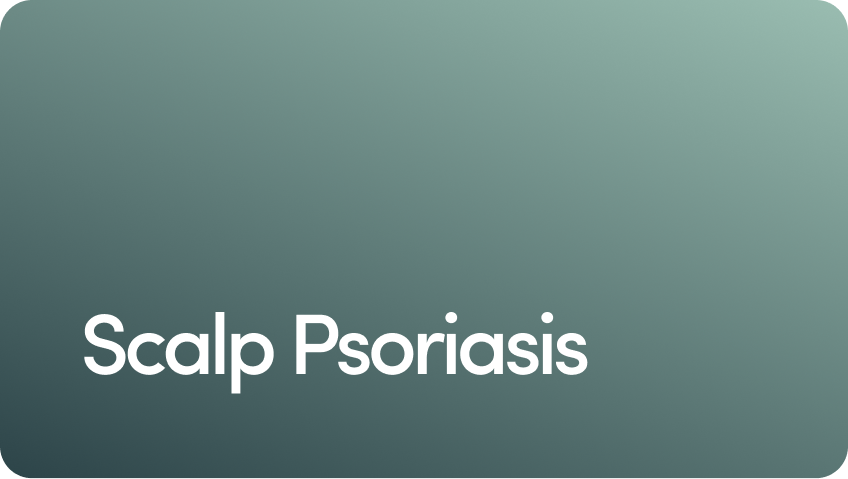Content
Thicker, fuller hair you'll love
Dry Scalp Treatment Tips

Reviewed by Sara Harcharik Perkins, MD
Written by Jill Seladi-Schulman, PhD
Published 04/11/2022
Updated 04/08/2025
Itchy, flaky, irritated — not exactly words you want associated with your scalp, right? But if you have a dry scalp, that’s likely exactly what you’ll experience. Dry scalp can be uncomfortable, and it can ruin a good hair day.
What can you do to get back to a healthy scalp? Thankfully, dry scalp treatments can help. But first, you’ll want to get to the bottom of what’s causing the dryness.
Dry scalp can be a sign of several things, from dehydration to medical issues. Learn how to identify what’s happening with your scalp, then read our expert-sourced dry scalp treatment tips.
Content
What Causes Dry Skin on the Scalp?
Many different things can lead to a dry scalp — and before you know how to treat it, you have to know the source.
You can read every medical journal article and skin care blog on the Internet, but at the end of the day, your best bet is to schedule time to talk to a healthcare professional. They can assess your dry scalp situation and help you determine what’s causing it.
Some of the things they’ll be on the lookout for may include:
Environmental Factors and Aging
On a basic level, a dry scalp happens when the skin on your scalp loses too much moisture. These common, everyday factors can strip your scalp of moisture:
Harsh hair care, scalp care, or styling products. These can strip natural oils from the skin. When this happens, it can lead to dry hair and a dry scalp, causing scaling, irritation, and itching. Examples of ingredients that may contribute to a drier scalp include sulfates and parabens.
Weather changes. You may notice that your scalp becomes drier as the weather gets cold and dry. If you have existing scalp or skin conditions, a low temperature and humidity can also cause your symptoms to flare.
Getting older. Aging impacts your skin, including the skin on your scalp. Skin typically makes less oils and sweat as you get older, meaning it can become drier. The hormonal changes that happen with menopause also contribute to dryness.
Psoriasis
This medical condition, which is caused by genetic, environmental, and immune factors, causes skin cells to grow too quickly and build up. This leads to irritated, itchy, dry patches on the scalp called plaques.
Psoriasis can happen anywhere on your body, including on your scalp. Researchers estimate that 80 percent of people with psoriasis have scalp psoriasis.
Tinea Capitis
A dry, itchy scalp can also result from scalp ringworm, a fungal infection also known as tinea capitis. If you have scalp ringworm, you may notice irritated, itchy patches on your scalp and hair loss.
This infection forms on your scalp and within your hair follicles (specifically on the hair shaft). Scalp fungal infections are usually caused by fungi like Microsporum and Trichophyton species.
You should know that tinea capitis is a contagious infection. This means you can catch it when you come into contact with someone who has it — or they can catch it from you. While it’s most common in children and people with weakened immune systems, anyone can catch it.
Actinic Keratosis
Actinic keratosis is a precancerous skin condition that happens due to excessive exposure to sunlight and UV rays from tanning beds and sunlamps.
An actinic keratosis lesion can appear as a patch of dry, scaly skin. It may also cause skin discoloration, but isn’t necessarily itchy or painful.
About 40 million people in the United States develop actinic keratosis each year. The scalp is a common place for these lesions to form since it’s often left exposed to sunlight.
What About Dandruff and Seborrheic Dermatitis?
We often use the terms dry scalp and dandruff interchangeably. But, these are actually two separate conditions with different causes.
While dry scalp is caused by a lack of moisture in the skin on the scalp, dandruff and its more severe form seborrheic dermatitis typically happen due to changes in the microbiome of the scalp, specifically overgrowth of Malassezia yeasts.
Dandruff often leads to flaking of skin from the scalp. Seborrheic dermatitis can happen in several places on the body, but is more common in areas — like the scalp — that produce more sebum, a waxy and oily substance made by sebaceous glands. It can lead to itchy red patches and greasy or yellowish scales and flaking.
Treating Dry Scalp
If you have a dry scalp, treating it will make your scalp feel much better. A medical professional is the best person to give you advice on how to address your dry scalp.
A dermatologist is a great place to start if you think you have a dry scalp. These medical professionals specialize in diagnosing and treating conditions that impact the skin, hair, and nails and can help determine what exactly is causing your dry scalp.
Knowing the cause of your dry scalp is important. That’s because it can inform the type of treatment a healthcare professional recommends.
Home Remedies
If your dry scalp is caused by the hair care products you’re using, your environment, or the natural effects of aging, you can take simple steps to rehydrate your scalp.
Consider trying out the following:
Select a gentle, nourishing shampoo that’s appropriate for your hair type.
Wash your hair based on when your scalp becomes oily or dirty. If you don’t typically have an oily scalp, this means that you’ll wash your hair less often.
Drink enough water, which can help your skin stay hydrated.
Find ways to effectively relieve stress, since increased stress levels may trigger psoriasis flares.
Use a humidifier to add some moisture to your home when the weather is cold and dry.
Try out topical products that may add moisture to your scalp, like ones containing coconut oil or olive oil.
Dry Scalp Medication
If home remedies haven’t been effective, you may need medical treatment. Treatment differs depending on the medical condition causing your dry scalp.
Scalp Psoriasis
If you have psoriasis on your scalp, you’ll most likely need prescription medication. This may come in the form of:
Corticosteroid foams or liquid solutions that you apply directly to your scalp
Medicated shampoos containing the corticosteroid clobetasol propionate
Scale softeners, a topical treatment that contains salicylic acids and helps reduce stubborn plaques
Light therapy, also called phototherapy
Stronger psoriasis medications that lower immune system activity
Scalp Ringworm
If tinea capitis is what’s behind your scalp dryness, your provider will likely prescribe antifungal medication, like griseofulvin.
Actinic Keratosis
A few different treatments are available for actinic keratosis.
A dermatologist may remove the lesion using cryotherapy or a chemical peel. Or, they may recommend a medicated cream to apply at home, containing active ingredients like 5-fluroouracil or imiquimod.
Dandruff and Seborrheic Dermatitis
Over-the-counter (OTC) anti-dandruff shampoos containing zinc pyrithione (like Head & Shoulders) can help with dandruff. Other active ingredients to look for include selenium sulfide, salicylic acid, and coal tar.
If you have seborrheic dermatitis, OTC dandruff shampoos may not always be effective. So your healthcare provider may recommend shampoos with higher-strength active ingredients like ciclopirox or ketoconazole. Many of these are prescription-only, though Nizoral shampoo is an example of a ketoconazole-based product that’s available OTC.
No matter what hair type you have, you may deal with a dry scalp at some point in your life.
Let’s recap what we know about dry scalp treatments:
Your chosen hair products could be the culprit. Many times, a flakey scalp is due to environmental factors like the type of shampoo you’re using. Try a different shampoo to see if your dry scalp improves.
You could have a medical issue. Skin conditions, like psoriasis or scalp ringworm, could be impacting your scalp health, leading to dryness. Treating the underlying issue may help with dry scalp symptoms.
You can try treating dry scalp with home remedies. Choosing gentle shampoos, keeping your scalp hydrated, and using OTC anti-dandruff products are all potential fixes for mild dry scalp.
You may need a prescription. In some cases, you may need to use medications, including prescription shampoos or creams, to manage a dry, irritated scalp.
If your scalp is dry and home remedies haven’t worked, consult with a healthcare provider like a dermatologist. From there, they can help you figure out what’s going on and suggest treatment options tailored to your needs.
17 Sources
- About psoriasis. (2025). https://www.psoriasis.org/about-psoriasis
- Actinic keratosis: Overview. (n.d.). https://www.aad.org/public/diseases/skin-cancer/actinic-keratosis-overview
- Al Aboud AM, et al. (2023). Tinea capitis. https://www.ncbi.nlm.nih.gov/books/NBK536909/
- Borda LJ, et al. (2015). Seborrheic dermatitis and dandruff: A comprehensive review. https://pmc.ncbi.nlm.nih.gov/articles/PMC4852869/
- Causes and triggers. (2025). https://www.psoriasis.org/causes
- Engebretsen KA, et al. (2016). The effect of environmental humidity and temperature on skin barrier function and dermatitis. https://pubmed.ncbi.nlm.nih.gov/26449379/
- Griseofulvin. (2017). https://medlineplus.gov/druginfo/meds/a682295.html
- Is your dry scalp something more serious? (2021). https://www.aad.org/public/everyday-care/hair-scalp-care/scalp/dry-scalp-conditions
- Lephart ED, et al. (2020). Menopause and the skin: Old favorites and new innovations in cosmeceuticals for estrogen-deficient skin. https://pmc.ncbi.nlm.nih.gov/articles/PMC7859014/
- Mijaljica D, et al. (2022). Skin cleansing without or with compromise: Soaps and syndets. https://pmc.ncbi.nlm.nih.gov/articles/PMC8954092/
- Mosca M, et al. (2021). Scalp psoriasis: A literature review of effective therapies and updated recommendations for practical management. https://pmc.ncbi.nlm.nih.gov/articles/PMC8163911/
- Mysore V, et al. (2022). Hair oils: Indigenous knowledge revisited. https://pmc.ncbi.nlm.nih.gov/articles/PMC9231528/
- Reinehr CPHR, et al. (2019). Actinic keratoses: Review of clinical, dermoscopic, and therapeutic aspects. https://pmc.ncbi.nlm.nih.gov/articles/PMC6939186/
- Ringworm and fungal nail infections basics. (2024). https://www.cdc.gov/ringworm/about/index.html
- Skin care and aging. (2025). https://www.nia.nih.gov/health/skin-care/skin-care-and-aging
- Tips for healthy hair. (2024). https://www.aad.org/public/everyday-care/hair-scalp-care/hair/healthy-hair-tips
- Tucker D, et al. (2024). Seborrheic dermatitis. https://www.ncbi.nlm.nih.gov/books/NBK551707/
Editorial Standards
Hims & Hers has strict sourcing guidelines to ensure our content is accurate and current. We rely on peer-reviewed studies, academic research institutions, and medical associations. We strive to use primary sources and refrain from using tertiary references. See a mistake? Let us know at [email protected]!
This article is for informational purposes only and does not constitute medical advice. The information contained herein is not a substitute for and should never be relied upon for professional medical advice. Always talk to your doctor about the risks and benefits of any treatment. Learn more about our editorial standards here.
Sara Harcharik Perkins, MD
Education
Bachelor of Arts, Biology, Economics, and Chemistry - University of Pennsylvania | College of Arts and Sciences, 2009
Doctor of Medicine - Icahn School of Medicine at Mount Sinai, 2014
Training
Internship, Internal Medicine | Massachusetts General Hospital, 2015
Residency, Dermatology | Yale New Haven Hospital, 2018
Medical Licenses
Connecticut, 2015
Board Certifications
Affiliations & Memberships
Specialties & Areas of Focus
Acne, hair loss, telemedicine, medical dermatology
Years of Experience
7
Previous Work Experience
Instructor - Department of Dermatology | Yale School of Medicine, 2018
Physician - VA Connecticut Healthcare System, 2018–
Assistant Professor - Department of Dermatology | Yale School of Medicine, 2019–
Publications & Research
Title: Characterization of electronic medical record patient portal messaging and the impact of the COVID-19 pandemic: A single institution experience.
Published in: Journal of the American Academy of Dermatology
Date: 2025
URL: https://www.sciencedirect.com/science/article/abs/pii/S0190962224030500
Title: Enduring gaps in representation: A comprehensive reanalysis of skin of color in popular medical education materials
Published in: Journal of the American Academy of Dermatology
Date: 2025
URL: https://www.sciencedirect.com/science/article/abs/pii/S0190962224030317
Title: Variation in state Medicaid coverage for asynchronous e-visits and e-consults
Published in: Journal of the American Academy of Dermatology
Date: 2025
URL: https://www.sciencedirect.com/science/article/abs/pii/S0190962224028718
Title: The impact of COVID-19 on the dermatologic care of nonmelanoma skin cancers among solid organ transplant recipients
Published in: Journal of the American Academy of Dermatology International
Date: 2023
URL: https://www.sciencedirect.com/science/article/pii/S2666328723001293
Title: Delays in melanoma presentation during the COVID-19 pandemic: A nationwide multi-institutional cohort study
Published in: Journal of the American Academy of Dermatology
Date: 2022
Quotes or Expert Insights
“Applying sunscreen every day is the most important thing you can do to keep your skin looking healthy and prevent skin cancer” | Time Magazine
Media Mentions & Features
Do Eye Creams Actually Work for Wrinkles? | Ask Well | The New York Times
Why I Practice Medicine
I love practicing medicine because it allows me to blend science, empathy, and problem-solving to improve my patients’ lives in tangible, visible ways. It’s so rewarding when patients feel seen, understood, and confident in their skin.
Hobbies & Interests
Spending time with my children, DIY projects, running
Professional Website or Profile
Related Conditions
 Alopecia Areata
Alopecia Areata
 Dandruff
Dandruff
 Itchy Scalp
Itchy Scalp
 Folliculitis
Folliculitis
 Scalp Psoriasis
Scalp Psoriasis
 Hair Loss
Hair Loss